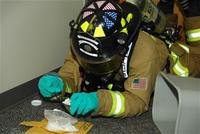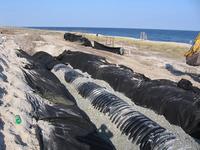-
Finding the right tools to respond to suspicious powder incidents

HazMat teams across the United States respond to hundreds of white powder calls each year in large cities where quick decision-making is critical. DHS makes it easier to buy the right technology for bio-threat incidents.
-
-
New device will quickly detect botulinum, ricin, other biothreat agents
Researchers are developing a medical instrument which will be able quickly to detect a suite of biothreat agents, including anthrax, ricin, botulinum, shiga, and SEB toxin. The device, once developed, approved by the Food and Drug Administration (FDA), and commercialized, would most likely be used in emergency rooms in the event of a bioterrorism incident.
-
-
Same-day water test keeps beaches open, swimmers’ health protected

With warm summer days at the beach on the minds of millions of winter-weary people, scientists are reporting that use of a new water quality test this year could prevent unnecessary beach closures, while better protecting the health of swimmers.
-
-
More than 10,000 pesticides approved by EPA without rigorous review
Congress allowed the Environmental Protection Agency (EPA) to use what is called “conditional registration” to approve pesticides deemed especially beneficial for food production – even before all the toxicity tests have been completed. Congress intended conditional registration to be used only sparingly, but the EPS has been using the loophole in a wholesale fashion to approve 65 percent – or more than 10,000 – of the 16,000 pesticides submitted to it for approval. The EPA cannot easily track the history of conditionally approved pesticides to determine whether required toxicity data was submitted, whether that caused a dangerous use of a pesticide to be cancelled, or whether the uses or restrictions should be modified based in such data.
-
-
Predicting disease outbreaks to protect soldiers -- and civilians
Researchers from Johns Hopkins University and the Pentagon develop a new method to predict dengue fever outbreaks several weeks before they occur. The method extracts relationships between clinical, meteorological, climatic, and socio-political data. It can be used in any geographical region and extended to other environmentally influenced infections affecting public health and military forces worldwide. DoD is currently evaluating the method for use in mitigating the effects of infectious disease in various operational settings.
-
-
Hidden dune filters treat coastal stormwater runoff

When it rains, untreated stormwater can sweep pollutants into coastal waters, potentially endangering public health. Now researchers have developed low-cost filtration systems that are concealed beneath sand dunes and filter out most of the bacteria that can lead to beach closures.
-
-
Antimicrobial resistance poses “catastrophic threat” to mankind
The U.K. Department of Health says that global action is needed to tackle the catastrophic threat of antimicrobial resistance, which in twenty years could see any one of us dying following minor surgery. A new report, providing a comprehensive overview of the threat of antimicrobial resistance and infectious diseases, highlights a “discovery void” with few new antibiotics developed in the past two decades. It highlights that, while a new infectious disease has been discovered nearly every year over the past thirty years, there have been very few new antibiotics developed, leaving our armory nearly empty as diseases evolve and become resistant to existing drugs.
-
-
Using plants for herbal defluoridation of drinking water

A filtration system based on a medicinal herb can quickly and easily remove “fluoride” from drinking water, say researchers in India. The technology uses parts of the plant Tridax procumbens as a biocarbon filter for the ion.
-
-
Arsenic in groundwater in Bangladesh naturally occurring
Human activities are not the primary cause of arsenic found in groundwater in Bangladesh. Instead, a team of researchers found that the arsenic in groundwater in the region is part of a natural process that predates any recent human activity, such as intensive pumping.
-
-
Sea surface temperature indicates onset of malaria epidemics
An estimated nine million malaria cases occur in India annually. Researchers find that sea surface temperatures in the tropical South Atlantic Ocean can be used accurately to forecast, by up to four months, malaria epidemics thousands of miles away in northwestern India.
-
-
New drug developed to combat flu pandemic
Scientists have helped to design a new drug to safeguard against epidemic and pandemic flu strains. The new drug has been proven to be effective in preventing the spread of different strains of influenza in laboratory models — including resistant strains of the virus.
-
-
Malaria infection risk influenced by daily variations in temperature
Identifying areas of malarial infection risk depends more on daily temperature variation than on the average monthly temperatures, according to researchers, who believe that their results may also apply to environmentally temperature-dependent organisms other than the malaria parasite.
-
-
Malaria can be defeated without a global eradication program
In 1955, the World Health Organization (WHO) launched a malaria eradication campaign that eliminated the disease in many temperate and subtropical regions but did not achieve worldwide eradication. The program was scrapped after less than two decades in favor of controlling malaria. WHO, however, attributed about 660,000 deaths to the disease in 2010, mostly African children. New research finds that malaria does not have to be eradicated globally for individual countries to succeed at maintaining elimination of the disease.
-
-
Six in ten people worldwide lack access to flush toilets, adequate sanitation
It may be the twenty-first century, with all its technological marvels, but six out of every ten people on Earth still do not have access to flush toilets or other adequate sanitation that protects the user and the surrounding community from harmful health effects.
-
-
Defusing the threat of ionizing radiation
The damage to Japan’s Fukushima nuclear reactor after the 2011 Tohoku earthquake raised concerns regarding U.S. preparedness to treat large-scale human exposure to ionizing radiation. Additionally, the immediate destructive potential of nuclear and radiological weapons, as well as their long-term health and economic impacts, continue to be of concern to DoD. Researchers look for novel approaches to mitigate immediate and long-term health damage from acute exposure to ionizing radiation and model its biophysical effects.
-
More headlines
The long view
A Shining Star in a Contentious Legacy: Could Marty Makary Be the Saving Grace of a Divisive Presidency?
While much of the Trump administration has sparked controversy, the FDA’s consumer-first reforms may be remembered as its brightest legacy. From AI-driven drug reviews to bans on artificial dyes, the FDA’s agenda resonates with the public in ways few Trump-era policies have.
